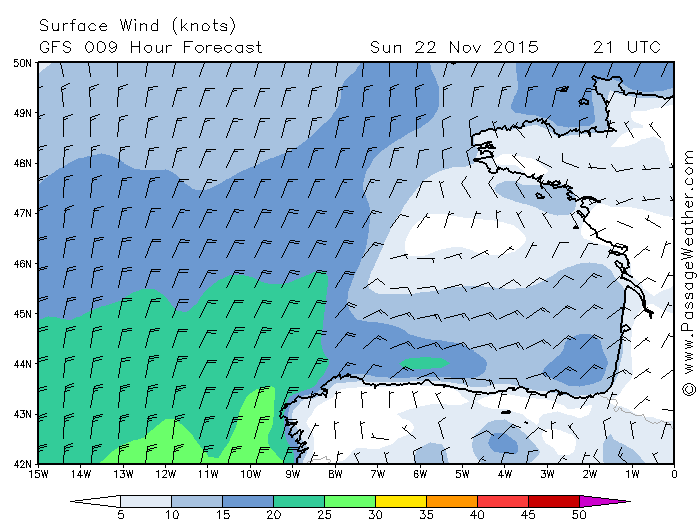IDEC Sport
Sailing fast across the bay of Biscay, IDEC sport, Francis Joyon and his 5 shipmates are anticipating a fast, perhaps record, run to the Equator. This is their press release.
JOYON’S MEN START TO ACCELERATE
Thirteen hours after setting off during the night from Ushant, Francis Joyon and his crew of five on the big trimaran IDEC SPORT are approaching Cape Finisterre, the north-western tip of Spain. There has been a huge acceleration since this morning. They can hope for a record run to the Equator.

YELLOW BRICK TRACKER screen shot showing the positin of German sailor Henrik Masekowitz in his Class 40 Croix du Sud. Henrik is bound around the globe also, although at somewhat slower speed. Depending on the track the two big tri’s take, well one hopes they know he is out there. Thirty knots is half a mile a minute…
The NW’ly wind has strengthened again in the Bay of Biscay and as they hoped this morning, IDEC SPORT has stepped up the pace since mid-morning. At 1300hrs UTC on Sunday 22nd November, eleven hours after they got underway (at 02:02:22 last night), the commando brigade on IDEC SPORT is already approaching Spain at the latitude of La Coruna. Anyone, who knows anything about sailing, will understand the extraordinary ability of these huge three-hulled boats to cross the Bay of Biscay in half a day. They can still look forward to reaching the Equator in under five and a half days, remembering that the record for this intermediate stretch is held by Loïck Peyron and his men with a time of 5 days and just under 15 hours.
Marcel Van Triest: “ideal in the North Atlantic”
The router Marcel Van Triest confirmed at 1500hrs this afternoon, “Even if the beam seas are stopping them from going too fast, we can’t grumble. We can sail across the Bay of Biscay on just one tack and only one gybe is likely before the Equator.” For him, there is the possibility of shaving 15 hours off the record for this first stretch, meaning they could move into the Southern Hemisphere in just five days. What happens after that? “Let’s say there is a 75% chance of getting a decent time to the Cape and a 35% chance of doing better than Banque Populaire (the record holder, editor’s note) which was very fast on this stretch between the Equator and the Cape of Good Hope.” On top of that, “tomorrow evening, the lads should be happy, as it will start to warm up, which will change things from what they have seen at the start of this attempt. Advancing at 30 miles per hour on the direct route, you soon make it to warmer climes. To be honest, the weather in the North Atlantic is looking very stable for them and almost perfect. ”
(COOP-edit) GFS Wx map from Passage Weather dot com for 2100z Sunday 22 Nov. Looks to be fast and straightforward for the next 48 hours. Just remember, 48 hours at 25 knots is 1200 miles though…
Francis Joyon and his men could not be contacted today, which is completely understandable: in the rush that you can expect at the start of such a record attempt, which is as prestigious as this Jules Verne Trophy, the sailors have to find their footing and often have more important things to deal with than communications. Particularly when you set off and immediately hit nasty seas, even before you have got to the start line.
Averaging 30 knots
Apart from the heavy seas, everything is going smoothly for the men on IDEC SPORT, sailing slightly to the east of the direct route. After a cautious start, partly due to the light winds in the first three hours of the attempt when the seas were nevertheless high, when the priority was to ensure the safety of the boat, the crew on IDEC SPORT put their foot down, helped by a NW’ly air stream that is shifting to the NE and strengthening. That is why since 0800hrs this morning, the average speed has been around thirty knots or more, as opposed to 15-25 in the first few hours after crossing the line. Mathematically, the slight loss in comparison to the reference time has been significantly reduced going from around 40 miles this morning at 0800hrs to 15 miles seven hours later. Getting back on equal footing is a possibility tonight in the first part of this record, and any gap is in any case insignificant at this stage. Indeed, we can see that they have managed to sail 336 miles in the first thirteen hours of this attempt.
For the moment, IDEC SPORT has avoided all the hurdles in the Bay of Biscay. They have pulled this off bobbing around on cross seas. On board, everyone is settling in and the six sailors are fully concentrated on what they are doing: avoiding breakages / sailing quickly without taking too many unnecessary risks / sailing downwind to try to get a remarkable record time to the Equator / then continuing on their way like this in the South Atlantic. So far, it’s been going incredibly well.
In short
. IDEC SPORT set off at 02:02:22 UTC on Sunday 22nd November 2015.
. The time to beat
Loïck Peyron and his crew (Banque Populaire) with a time of 45 days, 13 hours, 42 minutes and 53 seconds.
. Deadline
To smash the Jules Verne Trophy record, IDEC SPORT has to be back across the line before 1544hrs on Wednesday 6thJanuary.
. The crew
The international crew on IDEC SPORT includes just six men: Francis Joyon (FRA), Bernard Stamm (SUI), Gwénolé Gahinet (FRA), Alex Pella (ESP), Clément Surtel (FRA) and Boris Herrmann (GER)

